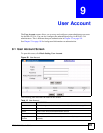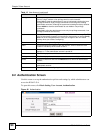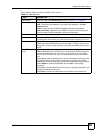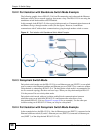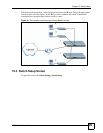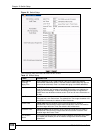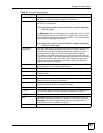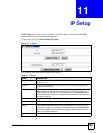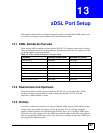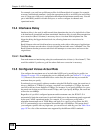
Chapter 10 Switch Setup
IES-612-51A User’s Guide
101
MAC Anti-Spoofing Select this if you want the IES-612-51A to generate an alarm and issue a SNMP
trap when an existing MAC address appears on another port.
Switch Mode Select Standalone to use both of the IES-612-51A’s Ethernet ports (ENET 1
and ENET 2) as uplink ports.
Note: Standalone mode is recommended for network topologies
that use loops.
Use Daisychain mode to cascade (daisychain) multiple IES-612-51A. The IES-
612-51A uses Ethernet port one (ENET 1) as an uplink port to connect to the
Ethernet backbone and uses Ethernet port two (ENET 2) to connect to another
(daisychained or subtending) IES-612-51A.
Note: Daisychain mode is recommended for network topologies
that do not use loops.
Priority Queue
Assignment
IEEE 802.1p defines up to 8 separate traffic types by inserting a tag into a MAC-
layer frame that contains bits to define class of service. Frames without an
explicit priority tag are given the default priority of the ingress port. Use the
following fields to configure the priority level-to-physical queue mapping.
The device has 4 physical queues that you can map to the 8 priority levels for
outgoing Ethernet traffic. The device has 8 physical queues that you can map to
the 8 priority levels for outgoing DSL traffic. Traffic assigned to higher index
queues gets through the device faster while traffic in lower index queues is
dropped if the network is congested.
Priority Level The following descriptions are based on the traffic types defined in the IEEE
802.1d standard (which incorporates IEEE 802.1p).
Priority 7 Typically used for network control traffic such as router configuration messages.
Priority 6 Typically used for voice traffic that is especially sensitive to jitter (jitter is the
variations in delay).
Priority 5 Typically used for video that consumes high bandwidth and is sensitive to jitter.
Priority 4 Typically used for controlled load, latency-sensitive traffic such as SNA
(Systems Network Architecture) transactions.
Priority 3 Typically used for “excellent effort” or better than best effort and would include
important business traffic that can tolerate some delay.
Priority 2 This is for “spare bandwidth”.
Priority 1 This is typically used for non-critical “background” traffic such as bulk transfers
that are allowed but that should not affect other applications and users.
Priority 0 Typically used for best-effort traffic.
Apply Click Apply to save your changes to the IES-612-51A’s volatile memory. The
IES-612-51A loses these changes if it is turned off or loses power, so use the
Config Save link on the navigation panel to save your changes to the non-
volatile memory when you are done configuring.
Cancel Click Cancel to begin configuring this screen afresh.
Table 15 Switch Setup (continued)
LABEL DESCRIPTION



